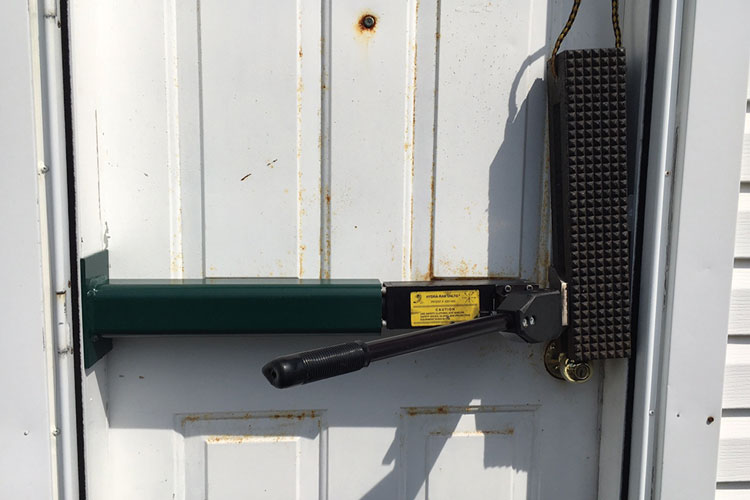
by ADAM J. HANSEN
Throughout the history of the American fire service, many tools in its “toolbox” have been invented and created by its very own members, which makes perfect sense. In all aspects of life, the idea for an invention comes when a task may not be going as planned and someone may think, “There has to be an easier way of doing this” or “If we only had a better tool.” It’s at those moments when the tools of our trade are created. This moment of clarity happened to my fellow member, Milford (CT) Fire Department (MFD) Lieutenant Mike Donegan, who not only thought of a new idea for a tool but was also driven to build it.
Donegan has been dedicated to the fire service for nearly 20 years. Throughout those years, he has continuously attempted to devise new ideas to help our department move forward. However, his “Frame Spreader” is his one contribution that I feel compelled to share with other firefighters (and not just the 125 MFD members) (photo 1).
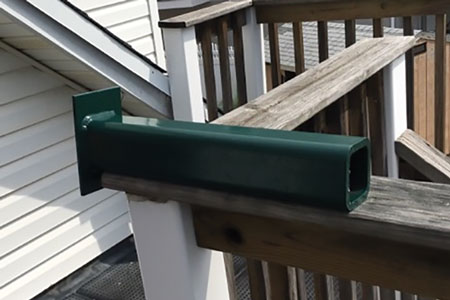 |
| (1) The Frame Spreader. (Photos by Mike Donegan.) |
Of the countless calls to which we respond each year, the majority are not working structure fires; they are medical calls, fire alarms, utility hazards, and other routine type emergencies. When we attempt to enter structures, sizing up the severity of the call is a must. In other words, if we pull up and find smoke showing, all bets are off – damaging the door and the frame is now the least of our worries. However, if we pull up to a one-story, wood-frame, single-family dwelling with nothing visible from the exterior and an audible alarm sounding, our sense of urgency immediately decreases. If you cannot make entry through an unlocked window or some other opening, then through-the-lock forcible entry is often the next least destructive method of gaining entry. Or is it?
While responding to these routine entry calls, Donegan began to think of a way to do the least amount of damage possible while still delivering quality customer service. He had an extensive background in carpentry. With this heightened awareness of home repairs, he became tired of going to these routine type calls and causing unnecessary damage.
Design and Construction
The Frame Spreader’s design is married to that of a hydraulic ram (photo 2), which has become a tremendously popular, common tool in fire departments around the world. The Frame Spreader is constructed of three-inch square steel tubing. Its interior opening measures 2¼ inches wide (photo 3); this size opening facilitates the clearance of the cylindrical-shaped base of the hydraulic ram. Once the cylinder base clears the inside opening, the Frame Spreader comes to rest against the square-shaped main body of the hydraulic ram. These dimensions allow for an extremely solid contact point that does not allow any excessive movement of either tool.
 |
| (2) The Frame Spreader and hydraulic ram joined together. |
The base of the Frame Spreader features a square heel plate made of steel. The heel plate allows for a solid contact point that rests against the door jamb, and its square shape helps distribute the pressure of the overall operation. This increased surface area prevents damage that would otherwise be produced if a smaller contact point had been used.
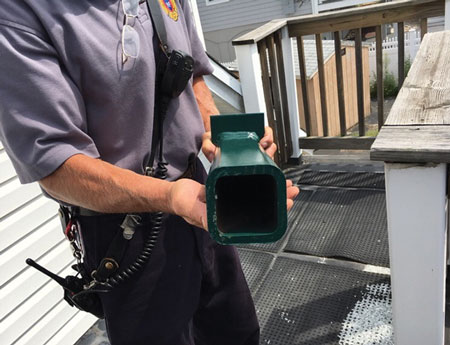 |
| (3) Interior view of the Frame Spreader. |
The Frame Spreader is 16 inches long from the base plate to the hydraulic ram contact point. This length allows the tool to be used with doors that are 30, 32 (photo 4), and even 36 inches wide. Although you do not need a four- × four-inch chock to obtain capture when forcing 30-inch doors, it is recommended that you use a two- × four-inch piece of cribbing (if it is available) or other suitable material that will increase the surface area against the opposite door jamb. Otherwise, the homeowner will have a “rabbit ears” indentation left in his door jamb. When attempting to spread doors that are 32 or 36 inches wide, you will need a four- × four-inch piece of wood or synthetic cribbing to create capture. Since this tool is meant to leave behind the least amount of damage possible, take the time to place a small piece of cribbing between the opposite jamb and the head of the hydraulic ram.
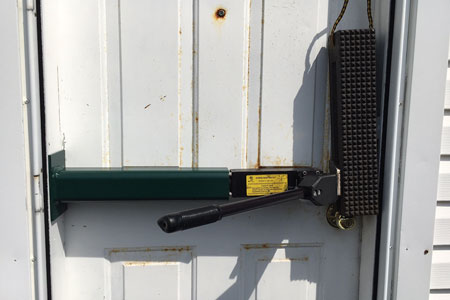 |
| (4-6) The Frame Spreader and the hydraulic ram set in a 32-inch door with a four- × four-inch piece of cribbing. |
Using the Frame Spreader
Used properly, the Frame Spreader will spread the door frame just enough to allow for the latch to clear from the strike plate. To carry out the actual frame spread, two firefighters are needed (mostly because the unit’s steel construction makes it quite heavy when it is in place). Next, place the cylindrical base of the hydraulic ram into the opening of the Frame Spreader until the base of the hydraulic ram comes to rest on the edge of the Frame Spreader. At this point, with the Frame Spreader and hydraulic ram being essentially one unit, lift the unit up and hold it horizontally, and set the unit just above the lock set. Ensure that the heel of the Frame Spreader is sitting flush and even against one of the jambs.
Next, place the four-inch chock as level as possible against the opposite door jamb. Once both firefighters are in position and confident that the unit is securely set, one firefighter will start to operate the hydraulic ram’s lever. Slowly pump the hydraulic ram until the latch clears the strike plate (the number of pumps needed will depend entirely on the width of the door frame). At this point, the door should swing open. As with all methods of forcible entry, control the door – you never know who or what could be behind it.
After you have successfully opened the door, slowly release the pressure of the hydraulic ram and ensure that both firefighters are ready to catch all objects and tools that are suspended; when the pressure is released, these objects will fall to the ground immediately. Remember, the hydraulic ram and Frame Spreader are heavy.
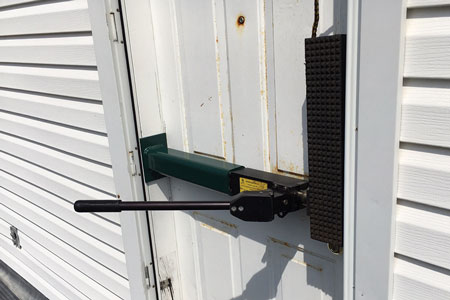
Limitations
Like any tool, the Frame Spreader has limitations. The door you are spreading needs to have the right construction features for the operation to be successful. The Frame Spreader is perfect for doors set within wood-frame construction; wood-framed features give the door’s structure more flex, which allows the frame to “bow out” and then return to its original dimension with little to no damage. A door set in concrete block with a metal frame could suffer significant damage.
It has been well documented that when applying just 138 pounds of force to the handle, the hydraulic ram can apply more than 10,000 pounds of force. These measurements make it possible to force a more fortified door such as one set in concrete. However, the tool’s purpose is to inflict as little damage as possible. This means you must draw on your knowledge and experience to dictate which doors are suitable for the tool’s use. If you start your operation and feel that spreading the frame to a certain point will cause significant damage to the door’s structure, stop the operation and go to your plan B.
A second construction feature to consider is the number and types of locks present on the door. The Frame Spreader is perfect to use on a door that has a single key knob lock. With the throw of the latch being rather short, it takes just a small spread of the frame to clear the strike plate. If the door happens to also be fitted with a deadbolt, the significantly longer throw of the bolt will mandate that you spread the frame much further, potentially causing significant damage. A third construction feature is an inward-opening door. Inward-swinging doors do not have an exposed/recessed frame to enable the tool to be set, preventing the tool from being used.
There is no set science behind which construction features must be present to use the Frame Spreader. Again, it is essential that you fall back on your knowledge and experience to know when you can be successful with this tool; if it is properly deployed, you should gain entry while creating little or no damage. If some damage to the door is sustained, it should be minimal and require nothing more than a few trimmed nails and a little paint. However, the homeowner will appreciate your finesse.
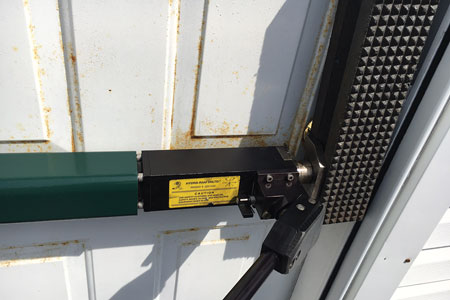
General Overview of Frame Spreader Use
Following are some precautions and tips you must consider when using this tool:
- Ensure the person creating the tool is a competent welder.
- Wear appropriate personal protective equipment to protect your eyes, head, ears, body, and so on.
- Use a heavy gauge material that can support the pressure the tool will create while in use. Steel was used in the above examples.
- Find the appropriate sized steel tubing. The hydraulic ram cylinder has a diameter of 2¼ inches. The three-inch square steel tubing that was used has a clear interior measurement of 25⁄16 inches. This measurement works perfectly, leaving 1⁄16 of an inch of clearance to facilitate a nice, tight fit.
- The three-inch square steel tubing was cut to 15¾ inches.
- A four- × six-inch steel heel plate ¼ inch thick was cut.
- The heel plate was centered at the base of the steel tubing and welded to the bottom.
- The tool was painted to match the colors of MFD Engine Company #6.
- Optional: You can weld a handle to the body of the tool. We decided against this because the handle could potentially limit the tool’s positioning if it were used in an operation other than forcible entry.
In these tough times when budgets are tight and discretionary spending seems to be shrinking by the day, creativity and ingenuity in the fire service are musts. If you have members in your department who are skilled tradespeople and can fabricate a tool like the Frame Spreader, make them feel like a valued member of the team and ask them to create a tool that fits the job.
For the past two years, the MFD’s Engine Company #6 used the Frame Spreader on 12 calls, each call ending with a successful outcome as well as positive feedback from the crew. The Frame Spreader isn’t something that you will use every day, but it is another tool to add to your ever-growing fire service “toolbox.” Hopefully, it will benefit others in the fire service.
Author’s note: If you or one of your members is interested in creating your own Frame Spreader, contact Mike Donegan at mdonegan@ci.milford.ct.us.
ADAM J. HANSEN is a 10-year veteran of and a lieutenant with the Milford (CT) Fire Department (MFD), where he is assigned to Engine Company #7. Prior to joining the MFD, he served as a volunteer with the Branford (CT) Fire Department. Hansen has a bachelor of science degree in fire science (fire administration) and a minor degree in criminal justice from the University of New Haven. He is also a nationally registered paramedic and a state certified fire service instructor I, fire officer I, incident safety officer, aerial and pump operator, and trench rescue technician.
Fire Engineering Archives

